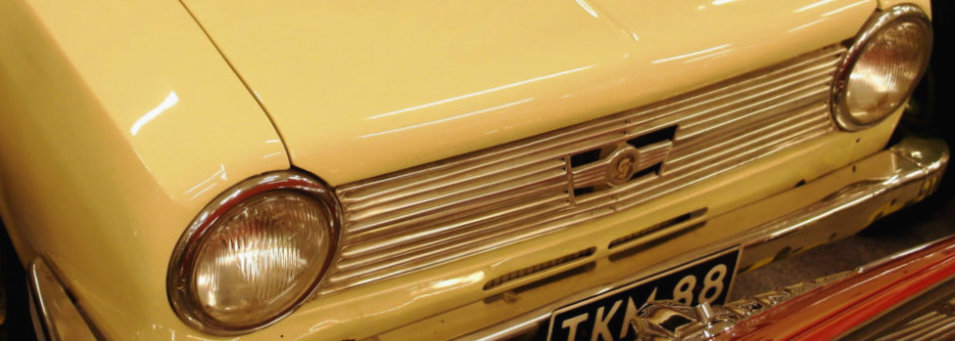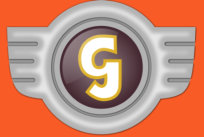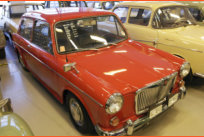












40.703 units made in Dingolfing, Germany

GLAS 1204 - 63
The Glas 1004 is a small two-door, four-seater automobile
produced by Hans Glas GmbH at Dingolfing. It was first
exhibited in public, in coupé form, at the Frankfurt Motor
Show in September 1961.
Volume production of the 1004 coupé started in May 1962, and in January 1963 saloon/sedan and cabriolet versions joined the range along with the more powerful Glas 1204. September
and cabriolet versions joined the range along with the more powerful Glas 1204. September 1965 saw a yet more powerful variant, the Glas 1304. In September 1966, a fastback
1965 saw a yet more powerful variant, the Glas 1304. In September 1966, a fastback Kombilimousine (estate) was added. The 04s were produced at least until December 1967,
Kombilimousine (estate) was added. The 04s were produced at least until December 1967, and new cars were listed for sale through much of 1968.
and new cars were listed for sale through much of 1968.
Origins
In 1960 the company’s research workshop came up with an engine that used an unconventional camshaft drive. Product developer Leonhard Ischinger, who had joined Glas
unconventional camshaft drive. Product developer Leonhard Ischinger, who had joined Glas from BMW, had produced a four-cylinder OHC engine with valve gear driven using a toothed
from BMW, had produced a four-cylinder OHC engine with valve gear driven using a toothed rubber cam-belt, which at that time was a novel idea. The 992 cc engine provided a
rubber cam-belt, which at that time was a novel idea. The 992 cc engine provided a maximum output of 31 kW (42 PS) at 5,000 rpm. During 1961 the company added a modern
maximum output of 31 kW (42 PS) at 5,000 rpm. During 1961 the company added a modern coupé body using the chassis of the Glas Isar which for this application had been lengthened
coupé body using the chassis of the Glas Isar which for this application had been lengthened by 10 cm. The result was the 1004 prototype which appeared at the Motor Show in
by 10 cm. The result was the 1004 prototype which appeared at the Motor Show in September of that year.
September of that year.
S 1004
Volume production began in May 1962 and the first cars were delivered in August. The car retained the water cooled 992 cc engine of the prototype which at this stage still delivered a
claimed 31 kW (42 PS) of maximum power at 5,000 rpm. Drive was to the rear wheels via a
retained the water cooled 992 cc engine of the prototype which at this stage still delivered a
claimed 31 kW (42 PS) of maximum power at 5,000 rpm. Drive was to the rear wheels via a four-speed manual transmission incorporating – still slightly unusually for this size of car –
four-speed manual transmission incorporating – still slightly unusually for this size of car – synchromesh on all four forward speeds.
The S 1004 came with a steel monocoque steel body strengthened, from the start on this
synchromesh on all four forward speeds.
The S 1004 came with a steel monocoque steel body strengthened, from the start on this model, by reinforcing box sections under the floor. Commentators noted the contrast
model, by reinforcing box sections under the floor. Commentators noted the contrast between the car’s relatively short 2,100 mm wheelbase and the overall 3,835 mm length of
between the car’s relatively short 2,100 mm wheelbase and the overall 3,835 mm length of the car, which may, by later standards, have compromised the handling but did permit the
the car, which may, by later standards, have compromised the handling but did permit the use of a relatively short drive-shaft.
use of a relatively short drive-shaft. Front suspension used trailing arms and independent springs in combination, while at the
Front suspension used trailing arms and independent springs in combination, while at the back a rigid “swing” axle was supported by leaf springs. Both at the front and at the back the
back a rigid “swing” axle was supported by leaf springs. Both at the front and at the back the suspension was enhanced with “rubber air-filled hollow springs”.
suspension was enhanced with “rubber air-filled hollow springs”. The hydraulically controlled drum brakes operated on all four wheels while the hand brake
The hydraulically controlled drum brakes operated on all four wheels while the hand brake operated via a cable linkage to the rear wheels. Steering was of the then common worm and
operated via a cable linkage to the rear wheels. Steering was of the then common worm and roller type.
roller type. The 2+2 coupé, commended in the manufacturer’s publicity for its “convincingly simple
The 2+2 coupé, commended in the manufacturer’s publicity for its “convincingly simple lines” was advertised at 5,595 DM, a price which increased to 5,865 DM in November 1963.
lines” was advertised at 5,595 DM, a price which increased to 5,865 DM in November 1963. From January 1963 the cabriolet was also offered, priced at a recommended 6,500 DM. The
From January 1963 the cabriolet was also offered, priced at a recommended 6,500 DM. The Glas 1004 had the smallest engine in the range, and this was offered in combination with the
Glas 1004 had the smallest engine in the range, and this was offered in combination with the full four seater sedan/saloon only from September 1965. A still unusual optional extra from
full four seater sedan/saloon only from September 1965. A still unusual optional extra from August 1963 was disc brakes on the front wheels, fitted for an extra 195 DM.
August 1963 was disc brakes on the front wheels, fitted for an extra 195 DM. Press comment in a country where technical innovation generates enthusiasm was very
Press comment in a country where technical innovation generates enthusiasm was very positive in respect of the car’s status as the world’s first production car to be fitted with a
positive in respect of the car’s status as the world’s first production car to be fitted with a belt driven camshaft, but criticised the unresponsiveness of the standard drum brakes and
belt driven camshaft, but criticised the unresponsiveness of the standard drum brakes and the heavy clutch. The car’s tendency to pitch under acceleration or sharp braking which was
attributed to its short wheel base also drew criticism as did the “back to front” gear box
the heavy clutch. The car’s tendency to pitch under acceleration or sharp braking which was
attributed to its short wheel base also drew criticism as did the “back to front” gear box which, as on the existing Isar, had originally been intended for a (never produced except as a
prototype) front-wheel drive small car and accordingly positioned first and third gears
which, as on the existing Isar, had originally been intended for a (never produced except as a
prototype) front-wheel drive small car and accordingly positioned first and third gears nearest to the driver, with second and fourth nearest the front of the car.
nearest to the driver, with second and fourth nearest the front of the car.
1204/S 1204
The full four seater arrived in January with the 1204 which had its cylinder stroke extended from 61 mm to 73 mm, to give an engine capacity of 1,189 cc and claimed maximum power
from 61 mm to 73 mm, to give an engine capacity of 1,189 cc and claimed maximum power of 39 kW (53 PS) at 5,100 rpm. The larger engined car was also offered as a coupé and as a
of 39 kW (53 PS) at 5,100 rpm. The larger engined car was also offered as a coupé and as a cabriolet.
cabriolet.
1004 TS/1204 TS
In November 1963 Glas added twin carburettor versions of both the 992 cc and 1,189 cc engined cars which were branded as the Glas 1004 TS and the Glas 1204 TS. Claimed
engined cars which were branded as the Glas 1004 TS and the Glas 1204 TS. Claimed maximum horsepower output on these twin carburettor powered cars were 46 kW (63 PS) at
maximum horsepower output on these twin carburettor powered cars were 46 kW (63 PS) at 6,000 rpm and 51 kW (70 PS) at 5,750 rpm respectively. The faster 1204 TS now came with a
6,000 rpm and 51 kW (70 PS) at 5,750 rpm respectively. The faster 1204 TS now came with a reported top speed of 160 km/h which matched the 100 mph barrier in the US, and put this
reported top speed of 160 km/h which matched the 100 mph barrier in the US, and put this relatively light-weight car on terms with several Porsche and Alfa Romeo sports cars in terms
relatively light-weight car on terms with several Porsche and Alfa Romeo sports cars in terms of straight line performance. The 1204 TS also managed acceleration from 0 to 100 km/h (63
of straight line performance. The 1204 TS also managed acceleration from 0 to 100 km/h (63 mph) in 11.9 seconds, although the car with this engine no longer offered “small car” levels
mph) in 11.9 seconds, although the car with this engine no longer offered “small car” levels of fuel economy. The TS powered versionsof the car came with front disc brakes included in
of fuel economy. The TS powered versionsof the car came with front disc brakes included in the price which provided, according to a contemporary report, “good stopping power with
the price which provided, according to a contemporary report, “good stopping power with little effort”. With the 1204 TS, in May 1964 Glas were offering for 6,980 DM a sporting and
little effort”. With the 1204 TS, in May 1964 Glas were offering for 6,980 DM a sporting and well appointed car that in many respects matched competitor vehicles priced at 10,000 DM
well appointed car that in many respects matched competitor vehicles priced at 10,000 DM or more.
In 1964 the Glas 1204 TS also enjoyed competition success. A 1204 TS driven by Gerhard
or more.
In 1964 the Glas 1204 TS also enjoyed competition success. A 1204 TS driven by Gerhard Bodmer finished in eighth position of the 86 cars that started in the 500 km Nürburgring race,
Bodmer finished in eighth position of the 86 cars that started in the 500 km Nürburgring race, achieving a class win in the process. The Bodmer/Schmidt partnership were equally
achieving a class win in the process. The Bodmer/Schmidt partnership were equally successful in the Spa-Francorchamps 24 hour race, finishing eighth overall and achieving a
successful in the Spa-Francorchamps 24 hour race, finishing eighth overall and achieving a class win ahead of their team-mates Lambrechts and Mombaerts in another 1204 TS.
class win ahead of their team-mates Lambrechts and Mombaerts in another 1204 TS.

1963
 Engine
1189 cc
4 cylinders
Power
70 HP
Top speed
160 km/h
Lenght/width
3,83 m/1,50 m
Weight
750 kg
Engine
1189 cc
4 cylinders
Power
70 HP
Top speed
160 km/h
Lenght/width
3,83 m/1,50 m
Weight
750 kg





Photos mainly by Matti Kreivilä. Historical facts and technical details of the vehicles provided by Wikipedia. Movies YouTube.






